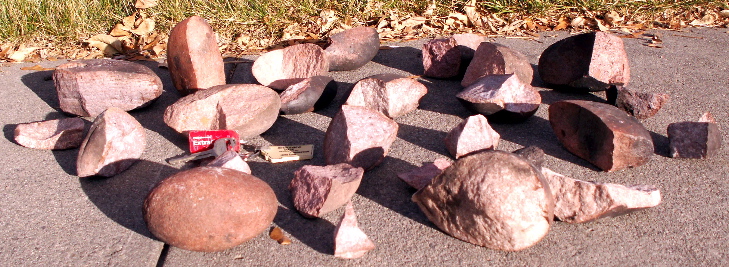

 Above: Quartzite comes in many different colors. These cobbles (rounded pieces), found in north-central Montana, were transported from Canada by ice age glaciers. The three angular pieces near the keys are from the rock room at Helena High. The keys are included to give you a sense of size. More about stone boiling, kill sites, and processing areas . . . 1. Although the previous page focused on how heated stones were used extract grease from bones, there were many other things going on in and around the processing area before, during, and after the boiling. For a complete description of every aspect of one kill site, I would recommend a book titled, Imagining Head Smashed In by Jack Brink. 2. Over 300 kill sites have been found in Montana and the many of these are not buffalo jumps. However, two of Montana's famous kill sites are jumps; the First Peoples Buffalo Jump and the Madison Buffalo Jump. At another well-known Montana kill site, Wahkpa Chu'gn in Havre, there is no cliff. Instead, buffalo were driven over a steep hillside into constructed wooden corrals where the dazed and injured animals were killed using either the atlatl or, later in time, bows and arrows. Click here to take a virtual tour of Wahkpa Chu'gn. 3. Processing areas have not been found near all kill sites. 4. Most kill sites were located near water because it's importance in the processing area. 5. Not all boiling was done in pits. Sometimes the water was held in a container made from the stomach of a buffalo, and supported by wooden branches stuck in the ground. Some tribes in the southwestern USA used tightly woven baskets for stone boiling. Tribes in forested areas also used birch bark to make containers. 6. Basalt (a fine-grained igneous rock) may be the ideal choice for boiling stones, but it is difficult to find in Montana, even among rocks transported by glaciers. 7. In addition to boiling to extract grease from bones, Indians used boiling to cook meat and to prepare other foods. 8. Fire-heated stones were also used to provide heat in roasting pits and sweat lodges. 9. Nutritious marrow from bison bones was a considered a delicacy. It was probably removed and eaten from roasted bones (with meat) before the bones were crushed for boiling. 10. Stone boiling was used by many different cultures all over the world to prepare a variety of foods. 11. Although all tribes on the northern plains used boiling stones, the Assiniboine tribe is actually named for this practice. "Assiniboine" is derived from a Chippewa phrase that means "those who cook with stones."
Even more, from an archaeologist's perspective . . . Fire-cracked rock (FCR): Stones which have fractured as a result of heating and cooling. Three FCR fracture types are recognized: 1. Water fractured FCR, characterized by rough hackly or jagged undulating fracture surfaces. 2. Heat spalled FCR typically characterized by concave ventral and convex dorsal surfaces, resulting in their superficial resemblance to chipped stone flakes. 3. Bedding fractured FCR characterized by fracture surfaces that follow bedding planes or pre-existing faults or fractures in the stone. Water fractured FCR is generally interpreted as resulting from stone boiling where stones heated to a high temperature are dropped into a water filled container. When all surfaces of these heated stones are so quickly cooled by water on all surfaces at once, the stones shatter into characteristically shaped pieces after one or more such immersions. Water fractured FCR is interpreted as reflecting food processing or food preparation activities, such as rendering grease for bone pieces, or cooking meat and other foodstuffs. Heat spalled FCR is interpreted as resulting from stones heated much more on one surface than another, with the result that heat spalled pieces exfoliate from the rock's surface. Stones where one surface is next to a hearth and the other is not, are commonly characterized by this fracture pattern. In cultural contexts, heat spalled FCR is commonly associated with stone roasting features; and at sweat lodges. In non-cultural contexts, heat spalled FCR can be created in forest fire areas subjected to intense heat. Bedding fractured FCR is largely dependant on the nature of the stone and may be created by either set of the conditions that create the other two fracture types and as such are not diagnostic indicators. The simple presence of FCR at an archaeological site is one of the best indicators that it reflects a campsite where a range of domestic cultural activities were taking place. The fracture patterns of FCR present allow us to infer weather food preparation or food processing is taking place by roasting or by stone boiling. Stone boiling: Process of heating water within a container by adding heated stones. The heated water is then commonly used in cooking or food processing. The stone boiling process commonly results in water fractured FCR. Watch the video . . . Click here to watch a 3-minute YouTube video called "The Boiling Stones Demonstration".  Above: Many of the cobbles that I used to boil the water (see video) cracked when I put them in the water. These would be classified as "water fractured FCR". |

 |
Back to the list of Montana Earth Science Pictures |
 |
BACK |
|
Earth Science Teacher at Helena High School |